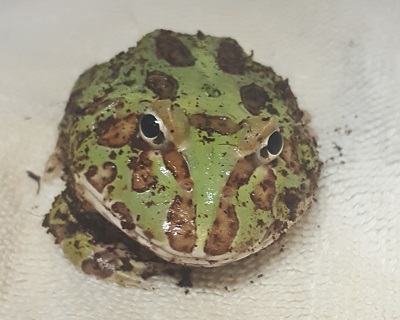
November is drawing to a close, which means we must say good-bye to our Animal of the Month the Pac-Man frog. If you’ve been following us on Twitter @ExoticPetVets, you will have seen that the Pac-Man frogs are not video game characters from the 1980’s, but are interesting amphibians who have mastered the art of the sedentary lifestyle. But if you missed any of our tweets about Pac-Man frogs, here is a summary that you can reference any time. Did you know?:
- It’s probably obvious that “Pac-Man frog” is not the official name of the Pac-Man frog. That’s their nickname because of their resemblance to the star of the popular 1980’s video game Pac-Man.
- Pac-Man frogs are officially known as ornate horned frogs (Ceratophrys ornata). They are also commonly known as Argentine horned frogs and horned frogs. The “horned” part of their name refers to the fold of skin above their eyes.
- Pac-Man frogs are endemic to Argentina. But they are also found in Uruguay and the southern-most part of Brazil.
- In the wild, Pac-Man frogs live in grasslands, near temporary bodies of water (such as seasonal ponds) and roadside ditches.
- Pac-Man frogs are so nick-named because their body shape is very round and they have very large mouths just like the video game character.
- Pac-Man frogs are large, measuring about 6 inches (15 cms) in length and width. Females are slightly larger than their male counterparts.
- The eyes of Pac-Man frogs sit on the tops of their heads. There is a fold of skin above their eyes, giving them a horned appearance.
- Pac-Man frogs can have different colours and mottled pattern variations on their skin. Their different colour combinations include various shades of green, brown, red, tan, yellow and orange. They also have white splotchy underbellies.
- Because Pac-Man frogs mostly live on land, they are not the best swimmers.
- Pac-Man frogs live a sedentary lifestyle. They are ambush predators and in the wild will spend most of their days buried in damp leaf litter waiting for their food to come to them.
- A Pac-Man frog will eat pretty much anything that will walk by them and fit into their mouths, including insects, mice, small reptiles, fish and other frogs.
- In captivity, Pac-Man frogs don’t need a lot of space since they don’t move around very much. But they do need to be housed alone as they are known to be cannibalistic and may eat their cage-mates.
- If food becomes scarce or if the environment becomes too dry, Pac-Man frogs will develop a tough outer skin layer in order to protect themselves from drying out.
- When Pac-Man frogs are encased in this tougher outer skin, they remain motionless and are often mistaken for being dead.
- When they are rehydrated, Pac-Man frogs will shed this tough outer skin and eat it. But it’s not ideal for Pac-Man frogs to go through this as it can cause them a significant amount of stress.
- Pac-Man frogs should not be handled by humans much – or at all. This is because their skin is very sensitive and can absorb things like the oils from our hands.
- Pac-Man frogs can become sick if they are handled too much by humans. It is also very stressful for them. It’s always best to leave them alone as much as possible.
- Pac-Man frogs will reach sexual maturity between 1 ½ and two years of age. When she finds a good location in a water source, the female will lay about 2,000 eggs.
- Once laid, Pac-Man frog eggs take about two weeks to hatch into tadpoles.
- Pac-Man frog tadpoles are very unique in that they can make distress calls! They can do this by forcing air out of their lungs, even though the lungs are still developing.
- It’s believed that Pac-Man frog tadpoles are currently the only vertebrate larvae that are capable of making distress calls.
- In the wild, Pac-Man frogs can live to about five years. But with proper care, Pac-Man frogs can live to an average of about 10 years in captivity.

